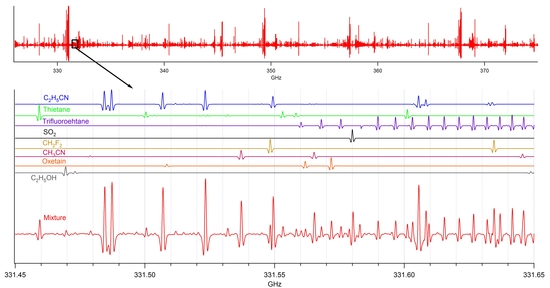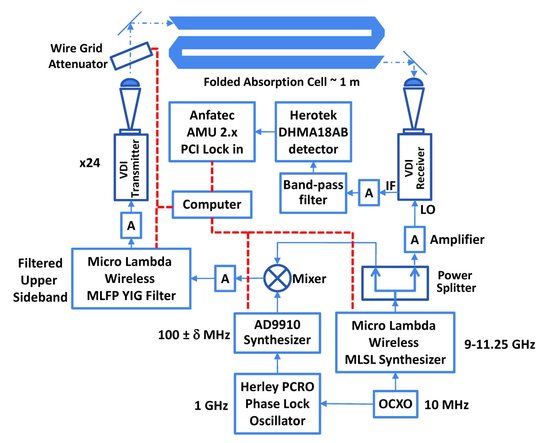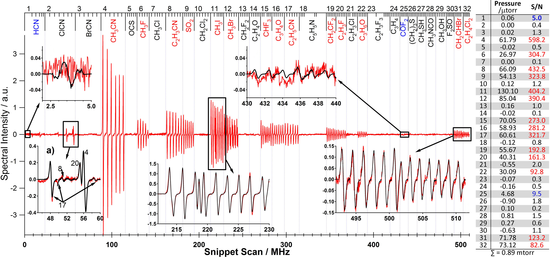
V. APPLICATIONS
C. Analytical Spectroscopy: A resurgence of interest in spectroscopic sensors has been fueled by increases in performance made possible by advances in laser systems and applications in medicine, environmental monitoring and national security [1-8]. Most of these new approaches make use of the optical/infrared (Op/IR) spectral regions [9-12]. The submillimeter spectral region, while much less well known, has also seen significant technological advances [13]. In the SMM it is possible to use frequency agile, synthesized electronic sources that can be multiplied into the SMM, with power outputs on the order of 1 mW, a power capable of saturating the probed molecules and which corresponds to 1014 K in a 1 MHz Doppler linewidth. In the SMM the thermal excitation of many rotational energy levels provides a fingerprint that is complexly redundant and resolvable, for even moderately large molecules, because of the small Doppler limit. These fingerprints, contained in more than 105 resolvable spectral channels, lead to ‘absolute’ specificity, even in complex mixtures [14-16].
SMM sensors based on electronic frequency synthesis and frequency multiplication are comparable to their optical counterparts [1, 2, 4, 7, 8] in terms of fractional concentration (ppx, x = m, b, t, . .) sensitivity and are orders of magnitude more favorable than time domain THz (TDS-THz) sensors [17, 18] or THz systems based on non-linear optical sources [19]. Systems based on pulsed lasers and difference frequency mixing have also been reported. If the sensitivity figure of merit is amount of sample, the lower optimum pressure (~10 mTorr) of SMM sensors increases their sensitivity by two to five orders of magnitude relative to Op/IR sensors or sensors based on SMM system with lower resolution.
V.C.1 The Physics and Spectroscopy of the SMM/THz

V.C.2 The Core Spectrometer

V.C.3 Typical Results of the Core Spectrometer

[1] Y. He, B.J. Orr, Appl. Phys. , B 85 (2006) 355-364.
[2] M.J. Thorpe, K.D. Moll, R.J. Jones, B. Safdi, J. Ye, Science, 311 (2006) 1595-1599.
[3] S.A. Diddams, L. Hollberg, V. Mbele, Nature, 445 (2007) 627-630.
[4] M.J. Thorpe, D. Balslev-Clausen, M.S. Kirchner, J. Ye, Optics Express, 16 (2008) 2387-2397.
[5] T. Gherman, D. Romanini, Opt. Exp., 10 (2002) 1033-1042.
[9] F. Keilmann, C. Gohle, R. Holzwarth, Opt. Lett., 29 (2004) 1542-1544.
[10] S.T. Sanders, Opt. Photonic New, 16 (2005) 36-41.
[11] J. Ye, M. Long-Sheng, J.L. Hall, Op. Lett., 21 (1996) 1000-1002.
[12] I. Debecker, A.K. Mohamed, D. Romanini, Opt. Exp., 13 (2005) 2906-2915.
[15] I.R. Medvedev, C.F. Neese, G.M. Plummer, F.C. De Lucia, Opt. Lett., 35 (2010) 1533-1535.
[16] I. Medvedev, M. Behnke, F.C. De Lucia, Appl. Phys. Lett., 86 (2005) 154105.
[17] S.A. Harmon, R.A. Cheville, Appl. Phys. Lett., 21 (2004) 2128-2130.
[18] B. Ferguson, X.-C. Zhang, Nature Materials, 1 (2002) 26-33.
[20] I. Medvedev, M. Behnke, F.C. De Lucia, Analyst, 131 (2006) 1299-1307.